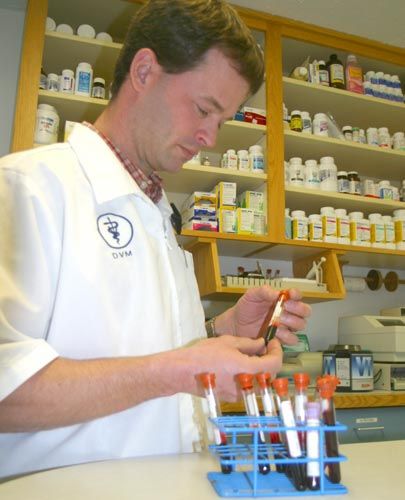Pigeon fever
Published 1:03 pm Saturday, December 15, 2007

- Veterinarian Chris McIlmoil of the Country Animal Clinic in Island City has seen an increase in pigeon fever cases. - The Observer/CHRIS BAXTER
Pigeon fever is bacterial infection caused
Trending
by Corynebacterium pseudotuberculosis and is characterized by deep
intramuscular – and sometimes internal – abscesses in horses. It has
also been called pigeon breast, dryland distemper and Colorado
Trending
strangles.
Pigeon fever was first reported in California in 1915. It
occurs sporadically in arid regions of the West and seems to be
expanding in territory. In recent years it has cropped up as far east
as Kentucky and Florida. This disease appeared for the first time in
eastern Oregon a few years ago, says veterinarian Chris McIlmoil,
Country Animal Clinic, Island City.
“The first cases we saw in our area were in
September 2004. My colleague, Dr. Mark Omann, has practiced here since
1988 and had never seen a case here in the valley. In 2004, we saw more
than 20, in 2005 we had a few less, then in 2006 we had more, and this
year we’ve seen nearly 50 horses with it. Most of these have had
external abscesses, but a few have also had internal abscesses,” he
says.
“When there are abscesses the main question is whether to treat
or not. We have established a treatment pattern. If the horse has one
or two external abscesses along the underline of the belly and they are
small, crusty abscesses, we can open them up and they drain out thick
pus. If that’s all there is, we just flush those out with dilute
Betadine and have the owner continue watching the horse. A lot of those
horses clear up and are fine. Another aspect of the disease is when
there are, in addition to the abscesses, some swellings due to fluid in
the tissues,” says McIlmoil. These swellings may go up to the muscles
in the breast or chest region or clear back to the udder or sheath.
“They may be any size from a couple centimeters up to 10 or 12
centimeters of edema along each side, spreading in long strips along
the belly. We may also see swollen pectoral muscles in the front. This
is where pigeon fever or pigeon breast gets its name,” he says. The
horse’s front is sticking out like the breast of a pigeon.
“When we see the swollen chest we often cannot drain the
abscess right away. It may take seven to 30 days to get to the point it
can be drained. The infection is presumed to travel in a certain type
of white blood cell and is spread via the lymph vessels,” he says. This
is why it can be so deep in the muscle. Inflammation can block the
vessels and this leads to the edema, he explains.
“There’s a very thick capsule around the abscesses in the
chest, thicker than a typical abscess. These must be opened surgically,
with a scalpel blade. Abscesses may appear in other areas as well.
We’ve seen abscesses in the udder, in the foreskin of male horses,
abscesses on the withers, hips, or just about anywhere on the horse,”
says McIlmoil.
“Now when we see a horse with any sort of swelling or abscess
on the body, we become suspicious and do a culture. We take a sample of
the material and send it to a lab to determine if this particular
bacterium is present. There is also a blood test that measures antibody
level. When we see a certain number, this is a high indicator for
internal abscesses,” he explains.
“If a horse has one abscess under the belly that we can just
drain, flush and have the owner monitor, and we don’t see any other
signs, we don’t feel there’s a need for antibiotics. If there’s
anything more than that, we do use antibiotics on that horse along with
draining and flushing, as well as using anti-inflammatory medication,
because it can be quite painful to the horse to have that much swelling
in the chest,” he says.
If a horse owner sees swelling or an abscess on a horse, they
should be in contact with a veterinarian and describe the condition.
“If someone calls and tells me the horse has one abscess and
it’s open and draining and wonders if they have to bring the horse in,
I usually tell them to continue watching, and keep me posted. Most of
the time, however, I want to see the horse, to fully answer the owner’s
questions. My responsibility as a veterinarian can’t be fully completed
without examining the patient. If a horse owner suspects a problem,
they need to consult a veterinarian,” he says.
There are puncture wound abscesses, for instance, that can
look just like a single pigeon fever abscess. It’s best to know exactly
what you are dealing with, McIlmoil says.
Pigeon fever infections generally appear during fall and early
winter months then subside after cold weather, with highest number of
cases in September, October and November.
“By December last year, for instance, we just had a couple
lingering cases that were internal abscesses. The fact that incidence
diminishes after cold weather lends credence to the idea the bacteria
may be spread by flies, but since the incubation period is not known –
and could be weeks to months – you could still have abscesses appear
even after the insects are gone,” he says. This is why cases may
continue into early winter.
“In summer, fly control might be helpful. There was a study at
UC-Davis, looking at risk factors. They recommended keeping your
pastures clean and practicing insect control, since these are logical
things that could help control the disease,” he says.
“Everyone who has a horse should be checking that horse daily,
looking closely at the underside checking for swelling because these
are the common areas where you will see abscesses. Every horse on your
place should be looked at daily, and this time of year it’s not always
easy because people are feeding morning and night in the dark. If you
do find swelling, contact your veterinarian, rather than just trying to
guess at what’s going on,” advises McIlmoil.
NOTE: Corynebacterium pseudotuberculosis can be spread to
humans. Potential mechanisms of transmission include drinking milk from
an infected goat or cow, handling contaminated equipment, exposure of
wounds to exudates/pus from abscesses.









